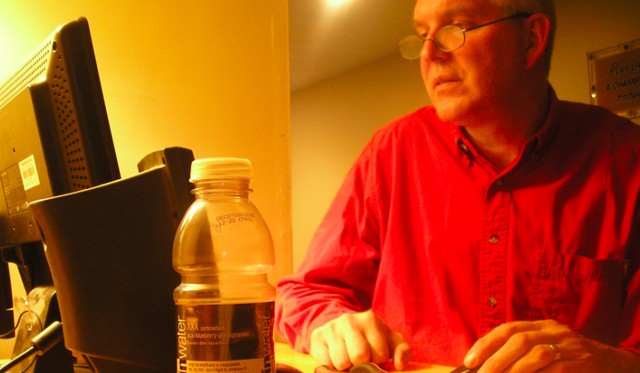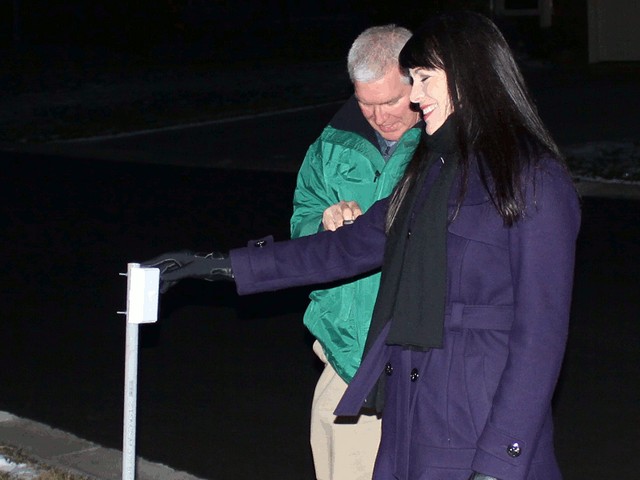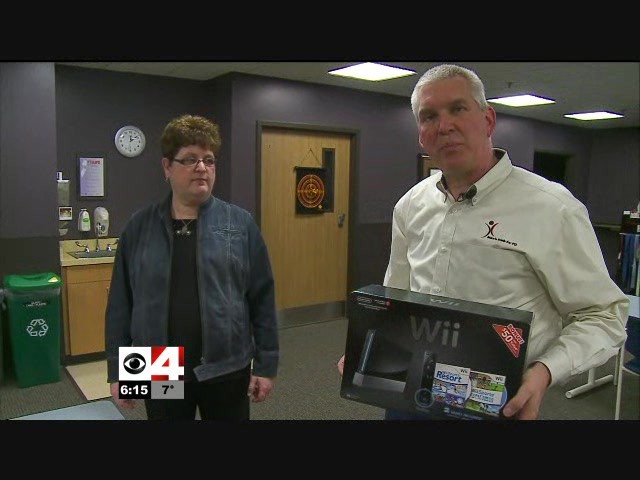Features
Every year, in Plymouth, Minnesota, Brother Mike Justak (Ball State) invests more than 500 hours in programming, assembling, and testing a six-house, sequenced, 60-minute Christmas light show. Just as every shimmer of light in the show is perfectly timed to the music played over FM radio, those 500 hours are coordinated to match Mike’s peak hours of performance on his Parkinson’s meds.
Considered “Young Onset,” Mike was diagnosed with Parkinson’s disease (PD) in 2004 at the age of 47. “By the time you’re diagnosed, up to 80% of your dopamine cells are already gone,” says Mike. He’s referring to the nerve cells in the brain that produce dopamine. Once there are visible symptoms, there is little hope of reversing the loss.
Those symptoms might include rigidity, slowing of movement, loss of balance, dysfunction in fine motor skills and speech, or—as the American public observed when Michael J. Fox revealed his diagnosis in 1999—tremors.
Justak has the least common form of PD, without tremors. “I’ve started to call it a ‘movement disorder.’ Most people with PD can’t get their bodies to stop moving. I can’t get my body to move,” he says. He specifically has trouble with repetitive motion on his right side. He’ll start to move his hand or foot normally, but without medication, his movements get smaller and smaller until they halt altogether.
That makes those 500 hours of multi-tasking as a computer programmer, electrical engineer, webmaster, DJ, and designer of a homegrown Christmas light show a bit more challenging than they would be for the ordinary person who doesn’t have training in any of those fields.
That’s right; Mike is an analyst by trade. He graduated with an accounting degree, but he says his Parkinson’s has helped him develop a creative side. What he knows about sequenced light shows he’s learned from others or by trial and error.

The same goes for managing his meds around his activities, especially the detailed preparations for the show, which take nearly half the year. “I’m either on or off. When people see me they say, ‘You look great,’” says Mike. What those people don’t realize is the synchronization of his meds necessary to ensure he doesn’t “shut off” in the middle of a conversation, event, or light show.
PD Shimmers – You Will Be Amazed!
Mike’s annual Christmas light show, now in its fourth year, is called “PD Shimmers”—a tongue-in-cheek reference to the tremors commonly associated with the disease. Created by a man undeterred by Parkinson’s disease, Mike’s goal is to create awareness for Parkinson’s. His tagline for this year’s show: “You will be amazed!”
The amazing will begin on November 29th, when 58,000 lights will shimmer and dance, recognizing the number of PD diagnoses in 2013. Video and voiceovers will remind viewers of the purpose of the production. “My lights shimmer and dance to remind the world that 1.25 million Americans are waiting for a cure. We will shimmer as long as people tremor,” he says. As has become the tradition, Plymouth Mayor Kelli Slavik will flip the switch this year to commence season four of PD Shimmers.
New to the show in 2013 is “Sparkle.” Mike’s recent invention was inspired by a new feature at Disneyland’s “World of Color” show—lighted Mickey Mouse ears that glow green and red on cue with the music.

Plymouth Mayor Kelli Slavik flipping the switch to commence Mike's annual PD Shimmers lights show.
“Sparkle” will allow audience participation in PD Shimmers. To pull it off, Mike wired a four-foot transparent plastic hollow wand to a battery pack with strings of battery-operated lights stuffed inside. He’s built seven wands, each with a different color and timing to match the show, and all are designed to sit at the base of a car windshield.
“This is Minnesota in December. No one will be standing in front of the house to watch.” Instead, volunteers will approach each car asking if they want to participate in the show with a Sparkle wand on their windshield. “I’m hoping the kids will like it,” says Mike.
Caring for the Parkinson’s Community
Mike is also the founder of the Mike Justak Foundation for Parkinson’s Disease (MJFPD), created in 2009 to promote awareness and provide resources to the community about the disease.
To date, there is no cure for Parkinson’s. In fact, the “best” PD drug was invented 50 years ago, and it still has some of the same pitfalls it had then. Today, care for patients is focused on easing the symptoms, and one of the best ways to do that is through movement.
Enter the MJFPD’s Wii-Initiative, which gets PD patients moving again in the comfort of their own home using the popular Nintendo Wii Fit. “It’s ‘move it or lose it’ with Parkinson’s,” says Mike. His foundation provides funding for new or repurposed Wii kits to eligible applicants including, most recently, a 40-year-old single mom. She was the perfect candidate; as a result, she is now able to move and play with her two-year-old daughter.
Exercise is such a crucial aspect of a PD patient’s treatment because it can increase dopamine production and potentially slow the progression of the disease. In addition, exercise has been tremendously helpful in reducing depression symptoms, a common side effect of PD.
Helping People to Help Themselves
When Mike became acquainted with David Zid, creator of ‘Delay the Disease,’ a PD-specific exercise program, he invited David to a symposium in Plymouth. During the symposium, David gave a quick lesson instructing PD patients how to rise from a chair unassisted.
As the lesson ended, Mike heard a woman in the back of the room saying, “It worked! I’m standing!” and saw her begin to cry. This was her first time to stand unassisted in six months. “My question of why I got Parkinson’s was answered that day. I am convinced I have PD to lead people to solutions to help themselves,” says Mike.
In September, Mike’s foundation was invited to participate in The Victory Summit® sponsored by the Davis Phinney Foundation for Parkinson’s, a charity named for the former professional cyclist and Olympic medalist who was diagnosed in 2000. The event is designed to help people living with Parkinson’s focus on improving their quality of life. As part of that mission, Mike donated a Wii to one lucky attendee who visited his booth during the Victory Summit and even got his picture taken with the famous cyclist.
Full of ideas for investing in the local Parkinson’s community, Mike is chartering two buses this year to take PD patients and caregivers out to see Christmas lights. One of the tours is designated for advanced patients who don’t often have the chance to get out socially.

Exercise is a crucial aspect of a PD patient's treatment because it can increase dopamine production and potentially slow the progression of the disease. Mike's foundation provides funding for new or repurposed Wii kits to encourage and facilitate movement in PD patients.
Two other pet-projects include creating a depository for first-generation Wii systems after families decide to upgrade and a video project called the “Faces of Parkinson’s” designed to bring awareness to the fact that Parkinson’s is not just a disease of the elderly. The latter is an effort Mike hopes will influence federal funding. Compared to cancer or heart disease, funding for Parkinson’s research is lagging by thousands of dollars per incident. “I’m trying to put a face to Parkinson’s. The squeaky wheel gets the grease; people need to know it’s not just the elderly who are diagnosed with PD,” he says.
Passing Down His Legacy
Mike and his wife, Karen, have four kids including two Sigma Nu legacies, Ryan and Greg, who currently attend North Dakota State University. Mike didn’t know there was a Sigma Nu chapter on campus until his eldest, Ryan, came home and announced he was a Sigma Nu candidate. A few years later Greg joined the chapter; he currently lives in the chapter house and serves as Treasurer, the same position his father held in the Theta Nu Chapter at Ball State.
A philanthropist like his father, Ryan is currently philanthropy chairman for the chapter and, this year, he instituted their first-ever haunted house. With great media coverage and a line around the block to get in, the chapter raised $5,000 for the American Heart Association.
Mike is thrilled his sons decided to pursue membership in Sigma Nu. “It helps you grow and gives you opportunities. Without a doubt, it was a valuable experience; I think it helps me to this day,” says Mike.
Though it’s been decades since his college days, one of his chapter brothers was recently reminiscing about a Halloween party in which Mike dressed up as a Christmas tree. “I had an electric cord running down my pant leg with 10 feet of slack so I could plug into a wall. The brothers all sang ‘O Christmas Tree’ as I stood in the corner. It was a story I’d long forgotten, but here I am, 40 years later, running my own Christmas light show.”
Although the show itself means hundreds of hours of painstaking work, not to mention the sacrifice of time with his family during one of the most family-centered times of the year, Mike says it’s worth it. “I have found something I can be passionate about. By doing this, I hope to inspire people who have problems in their lives to look for ways to contribute and help pay it forward.”